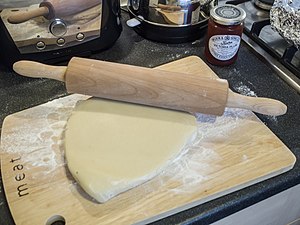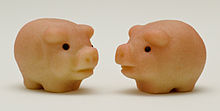Marzipan
 Plain marzipan being rolled flat | |
| Alternative names | Marzapane, marchpane |
|---|---|
| Type | Confectionery |
| Main ingredients | Almond meal, sugar |
| Variations | Persipan, Frutta martorana |
Marzipan is a
It is often made into
Around the world

Europe
The Geographical indications and traditional specialities in the European Union recognize two marzipans in Europe: one in Toledo (Spain)[2] and one in Lübeck (Germany).[3]
Southern Europe
In
Northern Europe
In Denmark, Sweden and Norway, it is customary to snack on marzipan pigs around Christmas, marzipan shaped as eggs around Easter, and kransekage on New Year's Eve.[7][8] It is also used in a large variety of cakes and confectioneries unrelated to the holidays, including træstammer, gåsebryst, and napoleonshatte, and as an ingredient in remonce-filling for Danish pastry.[9][10][11]
In Maiasmokk café in Tallinn, Estonia, there is a small museum dedicated to the history and manufacture of marzipan.[12]
Traditional Swedish princess cake is typically covered with a layer of marzipan that has been tinted pale green or pink.
Western and Central Europe

In Belgium and the Netherlands, ‘’marsepein‘’ (‘’marzipan’’) figures are given as Saint Nicholas's presents.
In France, massepain is the specialty of Saint-Léonard-de-Noblat, a town in Limousin. It comes in biscuit shape. It is also prepared in Gironde, it is named Girondin pudding made from hard bread, brown sugar and flavored with raisins soaked in rum.[13][14]

In Germany, it is common to gift marzipan in the shape of a loaf of bread (Marzipanbrot) or in the shape of small potatoes (Marzipankartoffeln) during Christmas time. Stollen can contain marzipan, and it is often featured as an ingredient in seasonal baked goods, such as Bethmännchen, Dominosteine and other Christmas cookies. One traditional new year present is known as a Glücksschwein ("lucky pig"). Mozartkugeln are a famed export of Austria made of marzipan balls dipped in dark chocolate.
In the United Kingdom, celebratory fruitcakes are decorated with a layer of marzipan- particularly Christmas cake which is covered with white sugar icing, and at Easter the Simnel cake contains a layer of marzipan, a further layer decorates the top and is lightly grilled or toasted to colour it. Battenberg cake, which originates in England, is covered in a layer of marzipan.[15]
In Geneva, a traditional part of the celebration of L'Escalade is the ritual smashing of a chocolate cauldron filled with marzipan vegetables, a reference to a Savoyard siege of the city which was supposedly foiled by a housewife with a cauldron of boiling soup.
Middle East
In Syria, marzipan (known as لوزینه lozina, lowzineh), or Marçabén (مرصبان) (Arabic word derived from lawz = "almond") is flavoured with orange-flower water and shaped into roses and other delicate flowers before they are baked. Marzipan can also be made from oatmeal, farina, or semolina.[16] For Jews in Iran, marzipan fruit is a traditional Passover treat, replacing biscuits and cakes.
The Americas
In
Asia
In the Indian state of Goa, marzipan (maçapão) was introduced from Portugal. However, the Goan version uses cashew nuts instead of almonds. Goan marzipan is used to make Easter eggs. It is also used to make Christmas sweets in various shapes like fruits, flowers, stars, etc. Similarly, in the city of Mumbai, the East Indians mould their cashewnut-based or almond-based marzipan into different shapes for Christmas and into marzipan eggs, chickens and bonnets for Easter.
In the
History
There are two proposed lines of origin for marzipan; they are not necessarily contradictory and may be complementary, as there have always been Mediterranean trade and cooking influences.[19] Other sources establish the origin of marzipan in China, from where the recipe moved on to the Middle East and then to Europe through Al-Andalus.[20]
Northeast Mediterranean line

The first mention of a similar dessert dates back to ancient Greece, where the culinary values of an almond and honey paste were already praised.
In the U.S., marzipan is not officially defined, but it is generally made with a higher ratio of sugar to almonds than
Iberian Peninsula line

Another possible geographic origin is the parts of Spain that were known as
Variations
Etymology
This section needs additional citations for verification. (March 2010) |

The German name has largely ousted the original English name marchpane with the same apparent derivation: "March bread". (The word marchpane occurs in Shakespeare's
The

Another source could be from Arabic موثابان mawthābān "king who sits still".[37] The Arabic, Latinised as matapanus, was used to describe a Venetian coin depicting an enthroned Christ the King.[38] These coins were stored in ornate boxes. From about the fifteenth century, when the coins were no longer in circulation, the boxes became decorative containers for storing and serving luxury sweetmeats. One such luxury that crept into the box in the sixteenth century is the now-famous almond-flavoured marzipan, named (at least proximately) after the box in which it was stored.
Production
To produce marzipan, raw almonds are cleaned "by sieving, air elutriation, and other electronic or mechanical devices",[39] then immersed in water with a temperature just below the boiling point for about five minutes, in a process known as blanching. This loosens the almonds' skin, which is removed by passing the almonds through rubber-covered rotating cylinders.[40] They are then cooled, after which they are coarsely chopped and ground, with up to 35% sugar, into almond flour.[41]
The almond flour mixture is roasted and cooled, after which sucrose (table sugar) and possibly a binding agent such as starch syrup or sorbitol are added.[41] It may then be moulded into any shape. Marzipan must be covered in an airtight container to prevent it from hardening and dehydrating. It should be protected from direct light to prevent rancidity of almond oil, a result of lipid oxidation.[citation needed]
Science
Molecular composition

The aroma and flavor of marzipan can in part be attributed to benzaldehyde, which is formed from Amygdalin
Physical structure
Marzipan is a food emulsion that contains four phases: a solid phase of suspended particles including almonds and sugars, a suspended air pocket phase formed from incorporated air during mixing, a water phase, and a lipid phase from almond oil.[42] The phases can separate when left alone for long periods of time. It is stabilized by the phospholipids and triglycerides found in the almond cells. The fatty acids found in almonds include saturated fats such as stearic acid and unsaturated fats such as linoleic acid.[43] Emulsifiers can be added during production to increase shelf life.
Marzipan's softness is a balance between the solid and liquid components. It should have a moisture content of less than 10%.[44]
See also
- Aboukir almonds – marzipan-covered almonds originating in Abu Qir
- Battenberg cake – a light sponge cake covered in marzipan
- Bethmännchen – a traditional German pastry which contains marzipan
- Cassata – a multi-layered Sicilian sponge cake covered in marzipan
- Frangipane – an almond-flavored pastry cream
- Halva – Some types are made from sesame paste or sunflower seed, butter and sugar
- Hübner Haus – Site of a former famous marzipan factory and pastry shop in Hamburg, Germany
- Frutta martorana – marzipan confectionary shaped and colored to resemble fruit
- Simnel cake – a light fruit cake covered in marzipan
- List of almond dishes
References
- ISBN 978-1-58980-897-3.
- ^ European Commission. "eAmbrosia". ec.europa.eu.
- ^ European Union. "eAmbrosia". ec.europa.eu.
- ^ Barer-Stein: 1999. Page 268
- ^ Barer-Stein: 1999. Page 356
- ^ "Turkish Patent and Trademark Office".
- Danmarks Radio. Retrieved 23 February 2021.
- ^ "Marcipangrisen" [The Marzipan-pig] (in Danish). Den Gamle By (Danish History Museum). 18 December 2014. Retrieved 23 February 2021.
- ^ "Marcipan: Lav konfekt, bagværk og søde sager" [Marzipan: Make confectionery, bakery and sweets] (in Danish). ALT.dk. Retrieved 23 February 2021.
- Danmarks Radio. 19 August 2016. Retrieved 23 February 2021.
- ^ "Bag en konditorklassiker! Lær at lave lækre napoleonshatte med Claus Meyer" [Bake a confectionery classic! Learn to make delicious napoleonshatte with Claus Meyer] (in Danish). bog.dk. 4 February 2021. Retrieved 23 February 2021.
- ^ "Kalev Marzipan Museum Room". Kalev. Archived from the original on 8 December 2015. Retrieved 8 September 2015.
- ^ "Les spécialités sucrées en Limousin | Limousin – Nouveaux Horizons". Limousin - Nouveaux Horizons (in French). Retrieved 2023-11-08.
- ISBN 978-88-7301-588-8.
- TheGuardian.com. 14 January 2016.
- ^ Barer-Stein: 1999. Page 245
- ^ Zalben, Lee (December 22, 2010). "What's the Deal with Marzipan?". Serious Eats.
- ^ ProQuest 373536791.
- ^ "Aramco World – Arabs, Almonds, Sugar and Toledo". Archived from the original on 2013-12-25. Retrieved 2017-09-27.
- ^ "Mazapan artesano de Toledo. Gastronomía en Castilla-La Mancha". Archived from the original on 2007-09-01.
- ^ Mazapan.es.
- ^ EU profile – Lübecker Marzipan (accessed 07/06/2009).
- ^ The main difference from the Luebeck style is that Königsberger Marzipan is browned on the surface and often has marmalade embedded in the centre. See German wikipedia entry here for more information. In Germany, the siblings of refugees from Königsberg still produce marzipan following traditional recipes, e.g. Gehlhaar confectioners in Wiesbaden (1912/45, seat Königsberg).
- ^ Welcome Love n Bake
- ^ "Ingredients & Nutrition Facts in Odensa Marzipan and Almond Paste".
- ^ "Lubeca Lübecker Marzipan-Fabrik – Lübecker Marzipan".
- ^ Islamyal.andalus.org Archived 2007-09-27 at the Wayback Machine.
- ^ EU Profile — Marzipan Toledo (accessed 07/06/2009).
- ^ "Mazapan". Archived from the original on 2003-07-27.
- ^ Minifie:1989. Page 594
- PMID 21999195.
- ^ Davidson et al: 2006. Page 484
- ^ Mendel: 2008. Page 288
- ISBN 978-0-7514-0331-2.
- ^ Chisholm, Hugh, ed. (1911). . Encyclopædia Britannica. Vol. 17 (11th ed.). Cambridge University Press. p. 691.
- ^ rae.es.
- ^ Etymonline.com.
- ^ Patridge: 1958.
- ^ Minifie: 1989, page 594.
- ^ Belitz et al: 2009, page 881. In the traditional production of marzipan raw filler, sweet almonds are scalded, peeled on rubber-covered rolls, coarsely chopped, and then ground with the addition of not more than 35% of sucrose.
- ^ a b Belitz et al: 2009, page 881.
- S2CID 94188094.
- ^ "Almond Board of California – Almond Composition" (PDF).
- ISBN 978-1-4613-1477-6.
Bibliography
- Barer-Stein, Thelma (1999). You Eat What You Are: People, Culture and Food Traditions. ISBN 1-55209-365-4.
- Belitz, Hans-Dieter; Grosch, Werner; Schieberle, Peter (2009). Food Chemistry. Springer. ISBN 978-3-540-69933-0.
- Davidson, Jane L.; Davidson, Alan; Saberi, Helen; Jaine, Tom (2006). The Oxford companion to food. Oxford: ISBN 0-19-280681-5.
- Mendel, Janet (2008). Cooking from the Heart of Spain. ISBN 978-0-7112-2873-3.
- Minifie, Bernard W. (1989). Chocolate, Cocoa, and Confectionery: Science and Technology. Berlin: ISBN 0-8342-1301-X.
- Patridge, E. (1958). "marchpane". Origins: a short etymological dictionary of the modern English. London: Routledge. p. 380.
External links
